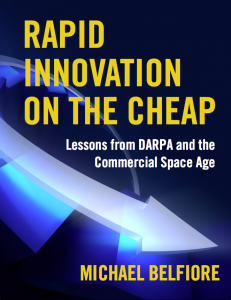Rapid Innovation
 I’ve posted a new, free paper on my website, called “Rapid Innovation on the Cheap: Lessons from DARPA and the Commercial Space Age.”
I’ve posted a new, free paper on my website, called “Rapid Innovation on the Cheap: Lessons from DARPA and the Commercial Space Age.”
This distills lessons learned from my reporting (ten years this year!) on some of the most extraordinary technology breakthroughs on the planet. As I’ve written about commercial space travel, the Defense Advanced Projects Agency, robotics, nanotech, and more for publications including National Geographic, the “Popular” magazines (Science and Mechanics), Reuters, and many others, I’ve found certain commonalities that make these programs and projects fly.
I’ve listed and I elaborate on seven of these commonalities driving the disruptive innovation I’ve been covering, and these are the focus of “Rapid Innovation on the Cheap.”
Along the way, I’ve teased out some answers that should be applicable to just about anyone seeking to do extraordinary things relatively quickly with relatively limited resources. These include:
- How having limited resources actually helps the process of creating disruptive innovation;
- How to keep fresh ideas coming into an organization that seeks to create positive change in the world;
- Why passion, not dollars, drives truly great research and development;
- Why risk-taking doesn’t have to mean betting the farm, and more.
Sign up here to get your free copy of “Rapid Innovation on the Cheap: Lessons from DARPA and the Commercial Space Age.” And let me know what you think. See some room for improvement? Something I’ve missed? Think I’m on to something here? Drop me a line!






